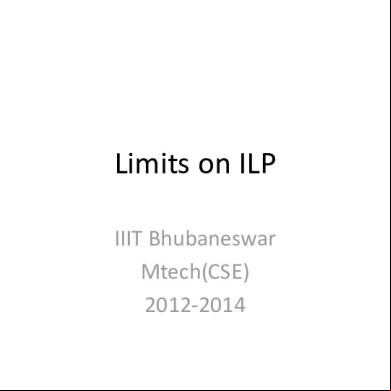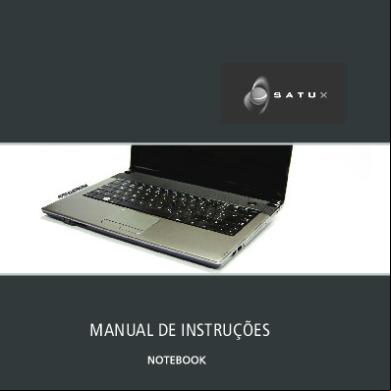Ilp Limitations 4l5f2q
This document was ed by and they confirmed that they have the permission to share it. If you are author or own the copyright of this book, please report to us by using this report form. Report 3b7i
Overview 3e4r5l
& View Ilp Limitations as PDF for free.
More details w3441
- Words: 1,057
- Pages: 31
Limits on ILP IIIT Bhubaneswar Mtech(CSE) 2012-2014
Achieving Parallelism • Techniques – Scoreboarding / Tomasulo’s Algorithm – Pipelining – Speculation – Branch Prediction
• But how much more performance could we theoretically get? How much ILP exists? • How much more performance could we realistically get?
Methodology • Assume an ideal (and impractical) processor • Add limitations one at a time to measure individual impact • Consider ILP limits on a hypothetically practical processor
• Analysis performed on benchmark programs with varying characteristics
Hardware Model – Ideal Machine • Remove all limitations on ILP – renaming • Infinite number of s available, eliminating all WAW and WAR hazards
– Branch prediction • Perfect, including targets for jumps
– Memory address alias analysis • All addresses known exactly, a load can be moved before a store provided that the addresses are not identical
– Perfect caches • All memory accesses take 1 clock cycle
– Infinite resources • No limit on number of functional units, buses, etc.
Ideal Machine • All control dependencies removed by perfect branch prediction • All structural hazards removed by infinite resources • All that remains are true data dependencies (RAW) hazards • All functional unit latencies: one clock cycle – Any dynamic instruction can execute in the cycle after its predecessor executes
• Initially we assume the processor can issue an unlimited number of instructions at once looking arbitrarily far ahead in the computation
Experimental Method • Programs compiled and optimized with standard MIPS optimizing compiler • The programs were instrumented to produce a trace of instruction and data references over the entire execution • Each instruction was subsequently rescheduled as early as the true data dependencies would allow – No control dependence
Benchmark Programs – SPECINT92
ILP on the Ideal Processor
How close could we get to the ideal? • The perfect processor must do the following: 1. Look arbitrarily far ahead to find a set of instructions to issue, predicting all branches perfectly 2. Rename all s to avoid WAR and WAW hazards 3. Resolve data dependencies 4. Resolve memory dependencies 5. Have enough functional units for all ready instructions
Limiting the Instruction Window • Limit window size to n (no longer arbitrary) – Window = number of instructions that are candidates for concurrent execution in a cycle
• Window size determines – Instruction storage needed within the pipeline – Maximum issue rate – Number of operand comparisons needed for dependence checking is O(n2) • To try and detect dependences among 2000 instructions would require some 4 million comparisons • Issuing 50 instructions requires 2450 comparisons
Effect of Reduced Window Size
Effect of Reduced Window Size
Effect of Reduced Window Size • Integer programs do not have as much parallelism as floating point programs – Scientific nature of the program
• Highly dependent on loop-level parallelism – Instructions that can execute in parallel across loop iterations cannot be found with small window sizes without compiler help
• From now on, assume: – Window size of 2000 – Maximum of 64 instructions issued per cycle
Effects of Branch Prediction • So far, all branch outcomes are known before the first instruction executes – This is difficult to achieve in hardware or software
• Consider 5 alternatives 1. 2.
Perfect Tournament predictor • (2,2) prediction scheme with 8K entries
3. 4. 5.
Standard (non-correlating) 2-bit predictor with 512 2-bit enteries Static (profile-based) None (parallelism limited to within current basic block)
• No penalty for mispredicted branches except for unseen parallelism
Branch Prediction Accuracy
Effects of Branch Prediction
Effects of Branch Prediction
Branch Prediction • Accurate prediction is critical to finding ILP • Loops are easy to predict • Independent instructions are separated by many branches in the integer programs and doduc • From now on, assume tournament predictor – Also assume 2K jump and return predictors
Effect of Finite s • What if we no longer have infinite s? Might have WAW or WAR hazards • Alpha 21264 had 41 gp and integer renaming s • IBM Power5 has 88 fp and integer renaming s
Effect of Renaming s
Effects of Renaming s
Renaming s • Not a big difference in integer programs – Already limited by branch prediction and window size, not that many speculative paths where we run into renaming problems
• Many s needed to hold live variables for the more predictable floating point programs • Significant jump at 64 • We will assume 256 integer and FP s available for renaming
Imperfect Alias Analysis • Memory can have dependencies too, so far assumed they can be eliminated • So far, memory alias analysis has been perfect • Consider 3 models – Global/stack perfect: idealized static program analysis (heap references are assumed to conflict) – Inspection: a simpler, realizable compiler technique limited to inspecting base s and constant offsets – None: all memory references are assumed to conflict
Effects of Imperfect Alias Analysis
Effects of Imperfect Alias Analysis
Memory Disambiguation • Fpppp and tomcatv use no heap so perfect with global/stack perfect assumption – Perfect analysis here better by a factor of 2, implies there are compiler analysis or dynamic analysis to obtain more parallelism
• Has big impact on amount of parallelism • Dynamic memory disambiguation constrained by – Each load address must be compared with all in-flight stores – The number of references that can be analyzed each clock cycle – The amount of load/store buffering determines how far a load/store instruction can be moved
What is realizable? • If our hardware improves, what may be realizable in the near future? – Up to 64 instruction issues per clock (roughly 10 times the issue width in 2005) – A tournament predictor with 1K entries and a 16 entry return predictor – Perfect disambiguation of memory references done dynamically (ambitious but possible if window size is small) – renaming with 64 int and 64 fp s
Performance on Hypothetical U
Performance on Hypothetical U
Hypothetical U • Ambitious/impractical hardware assumptions – Unrestricted issue (particularly memory ops) – Single cycle operations – Perfect caches
• Other directions – Data value prediction and speculation • Address value prediction and speculation
– Speculation on multiple paths – Simpler processor with larger cache and higher clock rate vs. more emphasis on ILP with a slower clock and smaller cache
Thank You
Achieving Parallelism • Techniques – Scoreboarding / Tomasulo’s Algorithm – Pipelining – Speculation – Branch Prediction
• But how much more performance could we theoretically get? How much ILP exists? • How much more performance could we realistically get?
Methodology • Assume an ideal (and impractical) processor • Add limitations one at a time to measure individual impact • Consider ILP limits on a hypothetically practical processor
• Analysis performed on benchmark programs with varying characteristics
Hardware Model – Ideal Machine • Remove all limitations on ILP – renaming • Infinite number of s available, eliminating all WAW and WAR hazards
– Branch prediction • Perfect, including targets for jumps
– Memory address alias analysis • All addresses known exactly, a load can be moved before a store provided that the addresses are not identical
– Perfect caches • All memory accesses take 1 clock cycle
– Infinite resources • No limit on number of functional units, buses, etc.
Ideal Machine • All control dependencies removed by perfect branch prediction • All structural hazards removed by infinite resources • All that remains are true data dependencies (RAW) hazards • All functional unit latencies: one clock cycle – Any dynamic instruction can execute in the cycle after its predecessor executes
• Initially we assume the processor can issue an unlimited number of instructions at once looking arbitrarily far ahead in the computation
Experimental Method • Programs compiled and optimized with standard MIPS optimizing compiler • The programs were instrumented to produce a trace of instruction and data references over the entire execution • Each instruction was subsequently rescheduled as early as the true data dependencies would allow – No control dependence
Benchmark Programs – SPECINT92
ILP on the Ideal Processor
How close could we get to the ideal? • The perfect processor must do the following: 1. Look arbitrarily far ahead to find a set of instructions to issue, predicting all branches perfectly 2. Rename all s to avoid WAR and WAW hazards 3. Resolve data dependencies 4. Resolve memory dependencies 5. Have enough functional units for all ready instructions
Limiting the Instruction Window • Limit window size to n (no longer arbitrary) – Window = number of instructions that are candidates for concurrent execution in a cycle
• Window size determines – Instruction storage needed within the pipeline – Maximum issue rate – Number of operand comparisons needed for dependence checking is O(n2) • To try and detect dependences among 2000 instructions would require some 4 million comparisons • Issuing 50 instructions requires 2450 comparisons
Effect of Reduced Window Size
Effect of Reduced Window Size
Effect of Reduced Window Size • Integer programs do not have as much parallelism as floating point programs – Scientific nature of the program
• Highly dependent on loop-level parallelism – Instructions that can execute in parallel across loop iterations cannot be found with small window sizes without compiler help
• From now on, assume: – Window size of 2000 – Maximum of 64 instructions issued per cycle
Effects of Branch Prediction • So far, all branch outcomes are known before the first instruction executes – This is difficult to achieve in hardware or software
• Consider 5 alternatives 1. 2.
Perfect Tournament predictor • (2,2) prediction scheme with 8K entries
3. 4. 5.
Standard (non-correlating) 2-bit predictor with 512 2-bit enteries Static (profile-based) None (parallelism limited to within current basic block)
• No penalty for mispredicted branches except for unseen parallelism
Branch Prediction Accuracy
Effects of Branch Prediction
Effects of Branch Prediction
Branch Prediction • Accurate prediction is critical to finding ILP • Loops are easy to predict • Independent instructions are separated by many branches in the integer programs and doduc • From now on, assume tournament predictor – Also assume 2K jump and return predictors
Effect of Finite s • What if we no longer have infinite s? Might have WAW or WAR hazards • Alpha 21264 had 41 gp and integer renaming s • IBM Power5 has 88 fp and integer renaming s
Effect of Renaming s
Effects of Renaming s
Renaming s • Not a big difference in integer programs – Already limited by branch prediction and window size, not that many speculative paths where we run into renaming problems
• Many s needed to hold live variables for the more predictable floating point programs • Significant jump at 64 • We will assume 256 integer and FP s available for renaming
Imperfect Alias Analysis • Memory can have dependencies too, so far assumed they can be eliminated • So far, memory alias analysis has been perfect • Consider 3 models – Global/stack perfect: idealized static program analysis (heap references are assumed to conflict) – Inspection: a simpler, realizable compiler technique limited to inspecting base s and constant offsets – None: all memory references are assumed to conflict
Effects of Imperfect Alias Analysis
Effects of Imperfect Alias Analysis
Memory Disambiguation • Fpppp and tomcatv use no heap so perfect with global/stack perfect assumption – Perfect analysis here better by a factor of 2, implies there are compiler analysis or dynamic analysis to obtain more parallelism
• Has big impact on amount of parallelism • Dynamic memory disambiguation constrained by – Each load address must be compared with all in-flight stores – The number of references that can be analyzed each clock cycle – The amount of load/store buffering determines how far a load/store instruction can be moved
What is realizable? • If our hardware improves, what may be realizable in the near future? – Up to 64 instruction issues per clock (roughly 10 times the issue width in 2005) – A tournament predictor with 1K entries and a 16 entry return predictor – Perfect disambiguation of memory references done dynamically (ambitious but possible if window size is small) – renaming with 64 int and 64 fp s
Performance on Hypothetical U
Performance on Hypothetical U
Hypothetical U • Ambitious/impractical hardware assumptions – Unrestricted issue (particularly memory ops) – Single cycle operations – Perfect caches
• Other directions – Data value prediction and speculation • Address value prediction and speculation
– Speculation on multiple paths – Simpler processor with larger cache and higher clock rate vs. more emphasis on ILP with a slower clock and smaller cache
Thank You










